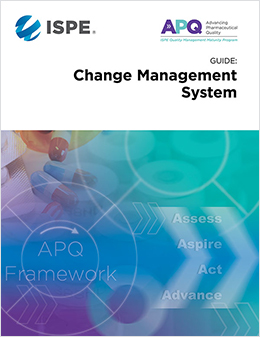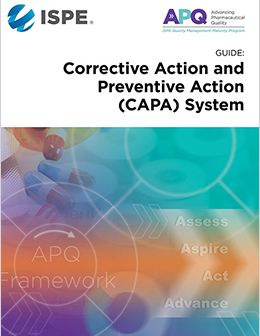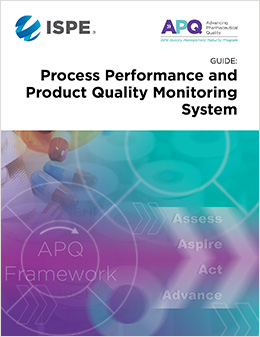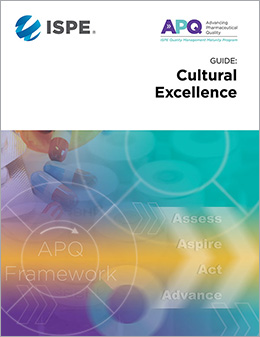Advancing Pharmaceutical Quality Cultural Excellence

Cultural Excellence is the expressed and implied ways in which an organization operates. Excellence in organizational culture is essential for delivering robust and sustained quality performance and ensuring patient-focused outcomes. Culture determines quality outcomes by affecting the organization’s ability to identify and act upon near-miss shortages, ensuring the integrity of its data, assuring transparent problem escalation, and striving for operational excellence.
ISPE’s Advancing Pharmaceutical Quality (APQ) program recently launched its latest guide, Cultural Excellence, the fifth and final guide in the series that seeks to improve the state of pharmaceutical quality and ensure sustainable compliance. The Guide Series is part of ISPE’s initiative, Advancing Pharmaceutical Quality (APQ), a comprehensive program for assessing and improving an organization’s quality management maturity.
Guide Co-Leads Erika Ballman and Nuala Calnan talked to iSpeak about the Guide.
1. What is the general idea of cultural excellence?
Nuala: Our definition of Cultural Excellence is a culture which fosters cross-functional ownership of quality and treats quality not as a hindrance, but a necessity that allows the company to make decisions that best benefit patients.
2. What is the connection between culture and industry best practices?
Erika: Cultural Excellence affects company performance in all areas: Quality, Operations, Supply Chain. A culture of excellence understands patient safety as paramount and recognizes quality not as an operational burden or compliance requirement, but an enabler that allows companies to make decisions that best benefit the patient.
Nuala: The successful pursuit of best practice is directly affected by the prevailing culture within a company. Culture manifests itself in the ways in which an organization operates, affects quality performance, supply chain excellence, and ensures that a patient-focus is maintained at all times. Culture actually determines organizational outcomes because it affects the organization’s ability to proactively identify and act upon risks, near-miss shortages, ensure the integrity of its data, assure transparent problem escalation, and strive for operational excellence, every batch, every day.
3. What are the positive impacts of nurturing a culture of excellence within a company?
Erika: The company will display clarity in its vision, purpose and values, with engaged employees who understand and embody the organizational values in the execution of their roles within the organization. A culture of excellence can lead to higher levels of employee engagement with clear performance objectives and metrics, including those for expected behaviors that promote, reward, and reinforce the desired culture. Employees are self-driven to deliver improvement and display pride of ownership in their work. Leaders work to build a culture by modeling the organizational values and patient focused behaviors to create an environment where their employees are empowered, speak up for necessary changes, and continually learn from mistakes, encouraging others to do the same.
4. How does cultural excellence fit into the APQ framework?
Nuala: Cultural Excellence acts as the foundation stone for all other elements of the APQ Program.
This premise is based on the belief that excellence in culture is fundamental to the delivery of sustained quality and performance improvement. Cultural Excellence focuses on developing the organizational capabilities which enable the advancement of quality management maturity for each of the other PQS elements.
Cultural Excellence focuses on leadership requiring management ownership and accountability, performance metrics that promote continual improvement, and a strong risk-management framework. All of which are key to the proactive identification and prevention of poor-quality outcomes across the other quality system elements.
As in other APQ guides, the application of a 5-level maturity model to Cultural Excellence will help companies score and understand their current level of cultural maturity and the areas in which focused improvement plans should be developed.
5. Why should someone purchase this Guide?
Erika: A company that advances quality management maturity beyond compliance preempts and detects manufacturing problems more readily, enables the company to act promptly and continually improve product quality, while also improving overall business performance.
There are practical applications within the guide that can help companies understand their own cultural journey. There are a range of practical approaches, tools, and case studies included in the guide which provide examples of how cultural excellence maturity can be assessed and advanced within a company. The comprehensive case study included in the guide appendix provides a step-by-step example, starting with the assessment through development of action plans for each of six key CE dimensions, as well as a useful guide on how to deepen the critical third-party relationships.
6. How will this Guide be helpful to others in the industry?
Nuala: The guide was contributed to by a cross-representative team that is working in industry and benchmarking from each other’s successes and learnings during the development of the content. The case study example and context are shaped by those in the pharmaceutical industry and represent multiple years of experience from Quality and Operational leaders in the subject of cultural improvement. The APQ methodology allows for the practical development of a site self-assessment process and concrete and actionable development plans that will drive performance.
7. How does this Guide differ from the 2017 ISPE Cultural Excellence Report?
Erika: It applies the APQ framework of Assess, Aspire, Act and Advance to Cultural Excellence improvement action planning. This CE guide also elaborates on improved Gemba Walk and Employee Engagement subjects through the application of Systematic Improvement Processes and Rewards and Recognition program best practices. Lastly, the guide includes third party cultural assessment tools, which is a new and industry-relevant subject matter for understanding and improving critical third-party partner relationships.
9. To your knowledge, is there any Guidance like this currently available?
Nuala: To our knowledge, the ISPE Cultural Excellence APQ Guide would be considered the first of its kind in combining industry best practices, a cultural excellence framework with rich content in each dimension, inclusion of key cultural enabling behaviors for employee and leader levels, and an effective Assess, Aspire, Act, Advance model for practical development of action plans. There are a range of practical tools and approaches to deploy as well as recommended Key Performance Indicators and Key Behavioral Indicators to support your advancement program.
Good Practice Guides
The program consists of five Good Practice Guides: one for each of the four elements of an ICH Q10 Pharmaceutical Quality System plus Cultural Excellence, bookended by an optional benchmarking tool developed by University of St. Gallen.
The APQ Program was developed by ISPE members and evolved from the ISPE Quality Metrics pilots, representing extensive industry engagement, collaboration with academia and other associations, and knowledge sharing with regulatory agencies.
Special Bundle Deal – Limited Time Offer!*
Save 30% on the APQ Guide Series
*Valid 18 November 2022 – 31 January 2023. Must buy all five Guides in the APQ Guide Series in a single purchase. This offer cannot be combined with other offers or the Emerging Economy discount.
Member Price: $750
Non-Member Price: $1,800






.jpg)




